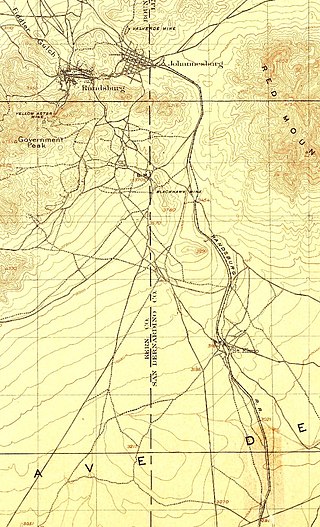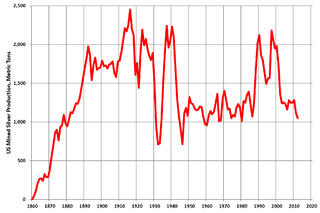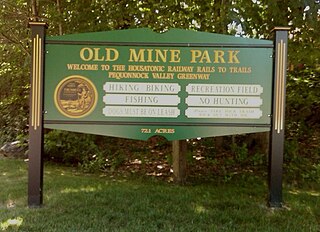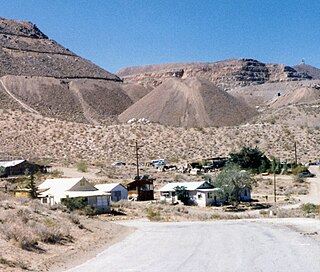
Johannesburg is a census-designated place (CDP) in Kern County, California, in a mining district of the Rand Mountains. Johannesburg is located 1 mile (1.6 km) east-northeast of Randsburg, at an elevation of 3,517 feet (1,072 m). The terminus of the Randsburg Railway was here from 1897 to 1933. The population was 172 at the 2010 census, down from 176 at the 2000 census. Johannesburg is divided from the neighboring community of Randsburg by a ridge. The town is frequently referred to as "Jo-burg" by locals and frequent visitors to the northwest Mojave.

Randsburg is a census-designated place (CDP) in Kern County, California, United States. Randsburg is located 17 miles (27 km) south of Ridgecrest, at an elevation of 3,504 feet (1,068 m). The population was 69 in the 2010 census, down from 77 in the 2000 census.

Sandvik AB is a Swedish multinational engineering company specializing in products and services for mining, rock excavation, rock drilling, rock processing, metal cutting and machining. The company was founded in Gävleborg County, Sweden, in 1862. In 2023, it had approximately 41,000 employees and a revenue of 127 billion SEK, with sales in around 170 countries.

Cantung Mine is a tungsten producer in the Nahanni area of the Northwest Territories, Canada, located northeast of Watson Lake in the Flat River Valley of the Selwyn Range close to the Yukon border. Tungsten was originally discovered in the area in 1954 by prospectors. Cantung Mine operated from 1962 to 1986, again from 2002 to 2003, and from 2005. Production was suspended from October 2009 to October 2010. The mine owner, North American Tungsten Corporation, went bankrupt in 2015 and the mine closed in October of that year. The federal government of Canada now owns the mine and has to clean up the site. As of December, 2017, the mine remained closed, with the possibility of being opened to process a nearby lithium deposit. As of February 2019, the mine is still closed; the federal and NWT governments are trying to sell it.

Mining in Cornwall and Devon, in the southwest of Britain, is thought to have begun in the early-middle Bronze Age with the exploitation of cassiterite. Tin, and later copper, were the most commonly extracted metals. Some tin mining continued long after the mining of other metals had become unprofitable, but ended in the late 20th century. In 2021, it was announced that a new mine was extracting battery-grade lithium carbonate, more than 20 years after the closure of the last South Crofty tin mine in Cornwall in 1998.

The Randsburg Railway was a 28.5-mile (45.9 km) branch line railroad in California's Mojave Desert. It originated at the main line of the Atchison, Topeka, and Santa Fe Railroad (AT&SF) at Kramer Junction, California, and terminated at Johannesburg, California, with a stop at Atolia. The Railway served as a supply link to the Rand Mine, which produced more silver than any mine in California. The Rand mine closed in 1929, as it was no longer profitable.

Silver mining in the United States began on a major scale with the discovery of the Comstock Lode in Nevada in 1858. The industry suffered greatly from the demonetization of silver in 1873 by the Coinage Act of 1873, known pejoratively as the "Crime of 73", but silver mining continues today.

The Cerro Gordo Mines are a collection of abandoned mines located in Cerro Gordo in the Inyo Mountains, Inyo County, near Lone Pine, California. Mining operations spanned 1866 to 1957, producing high grade silver, lead, zinc ore, and more rarely gold ore and copper ore. Some ore was smelted on site, but larger capacity smelters were eventually constructed along the shore of nearby Owens Lake.

Drakelands Mine, also known as Hemerdon Mine, Hemerdon Ball Mine or Hemerdon Bal Mine is a tungsten and tin mine. It is located 11 km northeast of Plymouth, near Plympton, in Devon, England. It lies to the north of the villages of Sparkwell and Hemerdon, and adjacent to the large china clay pits near Lee Moor. The mine had been out of operation since 1944, except for the brief operation of a trial mine in the 1980s. Work started to re-open it in 2014, but it ceased activities in 2018. It hosts the fourth largest tin-tungsten deposit in the world.

The mineral mining industry is a crucial piece of the Economy of Niger. Exports of minerals consistently account for 40% of exports.

Red Mountain, formerly known as Osdick, is an unincorporated community in San Bernardino County, California, United States.

The Old Mine Park Archaeological Site is a historic site in the Long Hill section of Trumbull, Connecticut, United States. It was mined from 1828 to 1920 and during 1942-1946, and has been incorporated in a municipal park. It was added to the National Register of Historic Places in 1990.
Roach is a ghost town and railroad siding in Clark County, Nevada, United States. It is located along the Union Pacific Railroad, between Jean, Nevada and Nipton, California.
Mooney Flat was an important mining and transportation hub in western Nevada County, California, just east of the Yuba County line. It was situated on modern Mooney Flat Road, about 1 mile north of modern Highway 20, at an elevation of about 800 ft.

Toulon is a former non-agency railroad station in Pershing County, Nevada, United States.
Tungsten is a ghost town in Boulder County, in the U.S. state of Colorado. The former townsite is north of Middle Boulder Creek.
Tempiute is a ghost town in Lincoln County, Nevada United States.

Canbelego is a village in the Orana region of New South Wales, Australia. It is now virtually a ghost town but was once a much larger settlement associated with the Mount Boppy Gold Mine. The name also refers to the surrounding rural locality identified for postal and statistical purposes. At the 2021 census, the population of Canbelego, including its surrounding area, was 54, up from 39 in 2016, but the village itself had only four residents in early 2020. Between 1907 and 1917, the population was around 2,000.

Yellow Aster Mine was a large gold mine in Southern California.

Illewong was a mining village, now a ghost town, in the Orana region of New South Wales, Australia. Prior to 1906, it was known as Bee Mountain. The area, in which Illewong once lay, is now part of Cobar, for postal and statistical purposes.


















